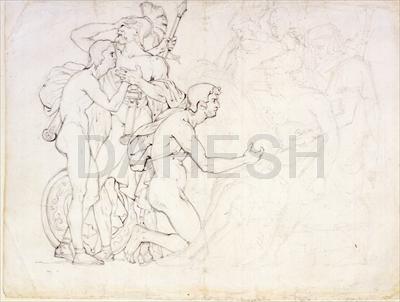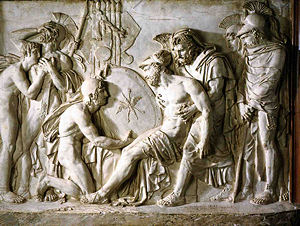Pierre-Jean David, called David d’Angers (French, 1788–1856)
Study for The Death of Epaminondas, after the Battle of Mantinea, 1811
Graphite on laid paper, 9 5/16 x 12 1/16 in.
Inscription on verso in graphite: David / Religieux et / Divers
Partial Gift of Shepherd Gallery, New York, 2003.15

In 1811, David d’Angers won the grand Prix de Rome for his large plaster relief, The Death of Epaminondas (see photograph). The subject is quite rare and derives from an ancient text by Diodorus of Sicily, the only historian who made mention of the Theban hero’s shield being brought to him after he was mortally wounded during battle. His friends crowded around him and cried: “Epaminondas, you will die without children!” “No,” he replied, “I will leave two daughters, namely the Victory of Leuctra and the Victory of Mantinea.” Diodorus wrote that “Then he quietly exhaled and they pulled the spear from his wound.”
Although it was difficult to visualize this subject, chosen for its exemplum virtutis (virtuous example), David d’Angers succeeded, in terms of design, perspective, the various degrees of expressing sorrow, and the overall composition. After the death of David d’Angers, the critic Durand wrote about this relief: “It is a page from Plutarch translated with a majestic simplicity and with an ancient and severe elegance.”

David d’Angers, The Death of Epaminondas, 1811, plaster, 111.5 x 159 x 22 cm [43 7/8 x 62 5/8 x 8 5/8 in.], Galerie David d’Angers, Angers


